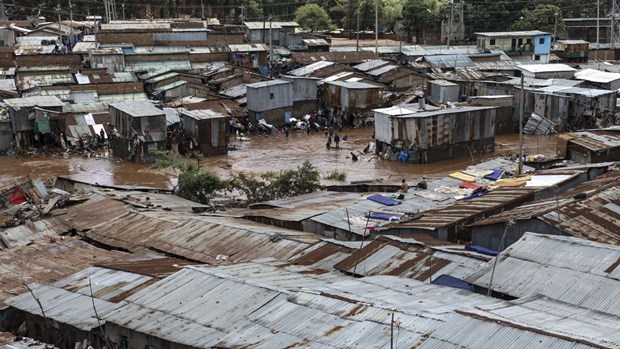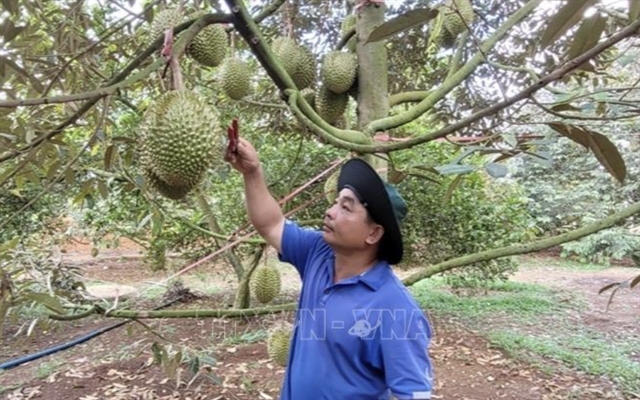 Society
Society

Nhơn Châu island commune in the central province of Bình Định is blessed with plenty of sea products, including seaweed. Porphyra, a cold-water seaweed found growing abundantly around rock pools here, has created a source of food and income for local residents.
 |
| A group of seaweed harvesters at work on Nhơn Châu island commune in the central province of Bình Định. — Photo tienphong.vn |
Lâm Chiêu Tranh
HÀ NỘI — Nhơn Châu island commune in the central province of Bình Định is blessed with plenty of sea products, including seaweed. Porphyra, a cold-water seaweed found growing abundantly around rock pools here, has created a source of food and income for local residents.
With a smooth texture and pleasant smell, the seaweed is often considered a type of vegetable and used to cook soup. It tastes salty at first and leaves a light sweet aftertaste as it is chewed.
As the men go out to fish at sea, the seaweed harvesters on the island are mostly women. Their day job often begins at five in the morning when they set out through a eucalyptus forest to get to a rock pool on the east side of the island where the seaweed grows. Some even bring along their children as no one will look after them if they are left at home.
Each harvester carries a set of equipment to collect the seaweed, consisting of a small basket, a spoon, and half a bottle of ash. “We think of our baskets as the father of seaweed harvesting,” said Phấn, a harvester. “We avoid changing them even when they are broken.”
The women all wear thick rubber sandals – the type of sandals that Vietnamese soldiers wore during the war – so that they can walk more easily on the rocks, whose surface is not only rugged but also slippery as it is covered by seaweed.
“Thick rubber increases friction,” said Phạm Mực, 82, a senior harvester. “Wear a pair of regular sandals and you will fall flat on your face.” Mực used to be a fisherman in the waters of central Quảng Ngãi Province. After a few seasons of crop failures, he returned to Bình Định Province and began harvesting seaweed.
It is not easy trying to balance on the slippery rocks and harvesting the seaweed, despite the thick sandals. The harvesters’ toes all turn red from holding on to the rocks as they sit in a squatting position to look for the plants.
Seaweed grows in the spring, summer and winter, but that which grows during the winter is considered the tastiest. The plants have a pleasant smell, are about a hand length (10 centimetres) and of a bluish black. “They should be harvested as soon as possible, otherwise they will turn into tasteless leaves,” Hương, a harvester, told Tien Phong.
One taste and the professional collectors know if the seaweed is in its prime. “It is hard to describe, but we have all grown accustomed to such a taste,” Hương said.
To get the seaweed, the harvesters sprinkle a layer of ash to make it less slippery, and then use spoons to scrape the strands from the rocks. The more experienced harvesters prefer pulling them out by hand to avoid breaking them off.
Being hard to find, in good seasons, seaweed can be sold at VNĐ3 million (US$132) per kilogramme. Sometimes demand outstrips supply.
But several collectors have lost their lives to the dangerous job. Every year on Nhơn Châu Island, some people were swept away by the waves while harvesting seaweed. Five people died last year on the Nhơn Lý, Nhơn Hải islands for the same reason. The latest case was on January 4 on the Cù Lao Chàm Island in the central province of Quảng Nam, when a 53-year-old seaweed collector was swept away and not found until late afternoon.
Mực, the 82-year-old Nhơn Châu harvester, once escaped death by a hair’s breadth. “Massive waves were hitting the shore,” he recalled. “I had to swim out far to sea and wait until they subsided to swim back.”
But they insist on keeping the job and go looking for seaweed even during bad weather. “Something is better than nothing,” said one Nhơn Châu harvester. — VNS









